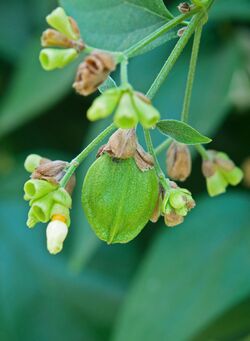Biology:Nyctanthes arbor-tristis
| Nyctanthes arbor-tristis | |
|---|---|

| |
| Scientific classification | |
| Kingdom: | Plantae |
| Clade: | Tracheophytes |
| Clade: | Angiosperms |
| Clade: | Eudicots |
| Clade: | Asterids |
| Order: | Lamiales |
| Family: | Oleaceae |
| Genus: | Nyctanthes |
| Species: | N. arbor-tristis
|
| Binomial name | |
| Nyctanthes arbor-tristis | |
| Synonyms[2] | |
| |
Nyctanthes arbor-tristis is a species of Nyctanthes native to South Asia and Southeast Asia.[2][3][4][5] It is commonly known as night-blooming jasmine, tree of sadness, tree of sorrow, coral jasmine[6] and in Singapore seri gading.[7] Despite its common name, the species is not a "true jasmine" and not of the genus Jasminum.
Names

The tree is called the "tree of sorrow" because the foliage becomes droopy as blooming flowers fall off during early morning.[8] The Latin specific epithet arbor-tristis means "sad tree".[8] In Nepal, Nyctanthes arbor-tristis is known as pārijāta (पारिजात), harsinghar, sephalika, pavalamallikai, manjapumaram, mannappumaram and siharu.[9] In Malaysia it is known as seri gading and in China it is referred to as nai hua or hung mo li.[9]
Description
Nyctanthes arbor-tristis is a shrub or a small tree growing to 10 m (33 ft) tall, with flaky grey bark. The leaves are opposite, simple, 6–12 cm (2.4–4.7 in) long and 2–6.5 cm (0.79–2.56 in) broad, with an entire margin. The flowers are fragrant, with a five- to eight-lobed white corolla with an orange-red centre; they are produced in clusters of two to seven together, with individual flowers opening at dusk and finishing at dawn. The fruit is a bilobed, flat brown heart-shaped to round capsule 2 cm (0.79 in) diameter, each lobe containing a single seed.[4][5]
Distribution and habitat
N. arbor-tristis is native to Indo-China, Himalaya and Sumatera to Jawa.[10] It grows in dry deciduous forests and hillsides.[11]
Uses
The leaves have been used in Ayurvedic medicine and Homoeopathy for sciatica, arthritis, and fevers, and as a laxative.[12] An orange dye from the corolla, nyctanthin, is used to dye silk.[13] In India, flowers are used to make garlands and used for worship.[8]
Culture
The flower of Nyctanthes arbor-tristis is the official state flower of West Bengal and is called shiuli or shefali.[13]
The native people of Tripura use the plant to help predict weather and rainfall.[14]
Literature
The parijata is a divine tree featured in Hindu mythology.[15] The Mahabharata and the Puranas describe the parijata tree, as one of five trees, to have emerged during the legend of the Samudra Manthana.[16] Krishna is described to have battled with Indra to uproot the parijata from his capital of Amaravati and plant it in his own city of Dvaraka.[15] In regional tradition, Satyabhama grew aggrieved when Krishna offered his chief consort Rukmini a parijata flower. To placate her envy, Krishna confronted Indra and had the parijata tree planted near Satyabhama's door. Despite having the tree planted near her dwelling, the flowers of the tree fell in the adjacent backyard of Rukmini, the favourite wife of Krishna, because of her superior devotion and humility.[17][18]
The tree is the subject of a work named Parijatapaharanamu in Telugu literature, written by Nandi Thimmana, the court-poet of Krishnadevaraya.[15] The poet Kalidasa sings about the flower in his Sanskrit poem Ritu samhara.[8]
See also
References
- ↑ IUCN SSC Global Tree Specialist Group; Botanic Gardens Conservation International (BGCI); Lakhey, P.; Pathak, J. (2022). "Nyctanthes arbor-tristis". IUCN Red List of Threatened Species 2022: e.T150224828A152201552. https://www.iucnredlist.org/species/150224828/152201552. Retrieved 23 January 2023.
- ↑ 2.0 2.1 Kew World Checklist of Selected Plant Families, Nyctanthes arbor-tristis
- ↑ {{citation | mode = cs1 | title = Nyctanthes arbor-tristis | work = Germplasm Resources Information Network (GRIN) | url = | publisher = [[Organization:Agricultural Research ServAgricultural Research Service (ARS), United States Department of Agriculture (USDA) | access-date = 16 December 2017 }}
- ↑ 4.0 4.1 Flora of Pakistan: Nyctanthes arbor-tristis
- ↑ 5.0 5.1 AgroForestry Tree Database: Nyctanthes arbor-tristis
- ↑ "Nyctanthes arbor-tristis". European and Mediterranean Plant Protection Organization (EPPO). https://gd.eppo.int/taxon/NCYAT.
- ↑ "Nyctanthes arbor-tristis". https://www.nparks.gov.sg/florafaunaweb/flora/2/2/2270.
- ↑ 8.0 8.1 8.2 8.3 Swaminathan, M. S.; Kochhar, S. L. (2019). Major Flowering Trees of Tropical Gardens. Cambridge University Press. pp. 258. https://books.google.com/books?id=vXSmDwAAQBAJ&dq=coral+jasmine+plant&pg=PA258.
- ↑ 9.0 9.1 Quattrocchi, Umberto (1999). CRC World Dictionary of Plant Names: Common Names, Scientific Names, Eponyms, Synonyms, and Etymology. CRC Press. pp. 1842. https://books.google.com/books?id=kaN-hLL-3qEC&dq=coral+jasmine&pg=PA1842.
- ↑ "Nyctanthes arbor-tristis L. | Plants of the World Online | Kew Science" (in en). http://powo.science.kew.org/taxon/urn:lsid:ipni.org:names:610599-1.
- ↑ Das, Debabrata (2023). Medicinal Plants and Traditional Knowledge in the Indian Subcontinent. Shashwat Publication. ISBN 978-93-95362-22-1. https://books.google.com/books?id=g2iqEAAAQBAJ&dq=coral+jasmine+plant&pg=PA129.
- ↑ "Tranquilizing, antihistaminic and purgative activity of Nyctanthes arbor tristis leaf extract". J Ethnopharmacol 81 (3): 321–5. August 2002. doi:10.1016/S0378-8741(02)00088-0. PMID 12127232.
- ↑ 13.0 13.1 Krishna, Nanditha (2014). Sacred Plants of India. Penguin UK. https://books.google.com/books?id=M_xsAwAAQBAJ&dq=official+flower+of+west+bengal&pg=PT346.
- ↑ Sandeep, Acharya (1 January 2011). "Prediction of rainfall variation through flowering phenology of night-flowering Jasmine (Nyctanthes arbor-tristis L.; Verbenaceae) in Tripura.". Indian Journal of Traditional Knowledge (Vol.10 (1), January 2011): 96–101. ISSN 0975-1068. https://www.researchgate.net/publication/292009604.
- ↑ 15.0 15.1 15.2 Dalal, Roshen (2014-04-18) (in en). Hinduism: An Alphabetical Guide. Penguin UK. pp. 917. ISBN 978-81-8475-277-9. https://books.google.com/books?id=zrk0AwAAQBAJ&dq=Parijata+Krishna&pg=PT917.
- ↑ Books, Kausiki (2021-10-24) (in en). Padma Purana Srishti Khanda Part 1: English Translation only without Slokas. Kausiki Books. pp. 56. https://books.google.com/books?id=dj9KEAAAQBAJ&dq=Parijata+churning&pg=PT56.
- ↑ Bryant, Edwin Francis (2007) (in en). Krishna: A Sourcebook. Oxford University Press. pp. 184–185. ISBN 978-0-19-803400-1. https://books.google.com/books?id=HVDqCkW1WpUC&dq=Parijata+Satyabhama+Rukmini&pg=PA185.
- ↑ Geybels, Hans; Herck, Walter Van (2011-03-17) (in en). Humour and Religion: Challenges and Ambiguities. A&C Black. pp. 39. ISBN 978-1-4411-6313-4. https://books.google.com/books?id=0VbqaHHywYYC&dq=Parijata+Rukmini&pg=PA39.
Wikidata ☰ Q764525 entry
 |



